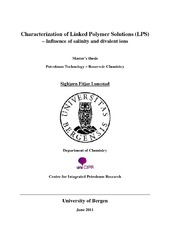Characterization of Linked Polymer Solutions (LPS) – Influence of salinity and divalent ions
Master thesis
Permanent lenke
https://hdl.handle.net/1956/5608Utgivelsesdato
2011-05-31Metadata
Vis full innførselSamlinger
- Department of Chemistry [433]
Sammendrag
Water flooding with addition of polymers cross-linked by polyvalent ions (LPS) has proven to increase the oil recovery both in field applications and laboratory studies, but with constraints on the brine salinity. With of an offshore LPS-application on the Norwegian continental shelf in mind, this thesis aimed to characterize the pressure build-up mechanisms thought to be responsible for the oil mobilization, for LPS in solvents with high ionic strengths, containing both mono- and divalent ions. During the present work, LPS solutions of partial hydrolysed polyacrylamide (HPAM) were solved in brines containing 0.5% NaCl, 5% NaCl, and 0.5% CaCl2 + 4.21% NaCl, at a constant polymer concentration of 300ppm, cross-linked by Al3+ at a polymer to aluminium ratio of 30:1. The LPS solutions were characterized by viscosity measurements and filter-floods, to investigate the pressure build-up properties of the solutions under variation of injection rates and pore sizes of the filters. The concept of LPS filter-flooding with variation of the flow rates has not been previously reported, thus a new method has been developed, tested, and verified. The new method has proven reliable and has indentified critical rates (Qc) for a sudden increase in differential pressure during filter-floods of LPS systems for increasing flow rates. Based on a proposed model for shear flow, the increased pressures cannot be explained solely by the shear thickening behaviour of LPS solutions, but is suggested also caused by the Log-Jamming effect, where intra-molecular cross-linked polymer coils accumulate at pore throats, causing local permeability reductions and flow diversion. The Log-Jamming ability of LPS solutions seems to decrease for higher brine salinity due to enhanced coiling of the polymer molecules. Addition of 0.5% by weight CaCl2 to LPS solutions under constant ionic strength seems to improve the Log-Jamming abilities, probably due to increased number of-, higher density of-, or higher affinity between the cross-linked particles. Addition of 0.5% by weight CaCl2 to a non-cross-linked polymer under constant ionic strength has proved to give equal pressure build-up properties and Log-Jamming ability as a corresponding LPS solution cross-linked by 10ppm Al3+ in a monovalent solvent. Addition of 1.0% by weight CaCl2 under the same conditions has proven to reduce the Log-Jamming ability, this is suggested due to repulsion between the cross-linked particles caused by oversaturation of the negative sites on the polymer molecules. This indicates that Ca2+ may substitute Al3+ as cross-linker in LPS solutions, but with a risk of lowered Log-Jamming abilities for sufficiently high Ca2+ concentrations.
